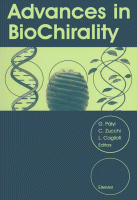Browse content
Table of contents
Actions for selected chapters
- Full text access
- Book chapterNo access
Chapter 2 - Dimensions of Biological Homochirality
Gyula Pályi, Claudia Zucchi and Luciano Caglioti
Pages 3-12 - Book chapterNo access
Chapter 3 - Chirality Algebra and the Right–Left Classification Problem
R.B. King
Pages 13-34 - Book chapterNo access
Chapter 4 - Theory of Biological Homochirality: Chirality, Symmetry Deficiency, and Electron-Cloud Holography in the Shape Analysis of Biomolecules
Paul G. Mezey
Pages 35-46 - Book chapterNo access
Chapter 5 - On the Biological Advantage of Chirality
Gideon Gilat
Pages 47-68 - Book chapterNo access
Chapter 6 - Origin of Biological Homochirality: Directed Selection or Random Motion?
Vladik A. Avetisov
Pages 69-83 - Book chapterNo access
Chapter 7 - Possible Mechanisms for Spontaneous Production of Enantiomeric Excess
David Z. Lippmann and Julio Dix
Pages 85-97 - Book chapterNo access
Chapter 8 - Search for the Origin of Homochirality of Biomolecules
Lajos Keszthelyi
Pages 99-103 - Book chapterNo access
Chapter 9 - The Role of Homochirality in Evolution
Zhao Nansheng
Pages 105-114 - Book chapterNo access
Chapter 10 - A New Method for Testing Models of Prebiotic Peptide Assembly
Melanie Bengtson and Eric D. Edstrom
Pages 115-123 - Book chapterNo access
Chapter 11 - Asymmetric Autocatalysis and Biomolecular Chirality
Kenso Soai and Takanori Shibata
Pages 125-136 - Book chapterNo access
Chapter 12 - Left-Right Asymmetry in Animal Embryogenesis
Michael Levin
Pages 137-152 - Book chapterNo access
Chapter 13 - Evolutionary Origin of Asymmetry in Early Metazoan Animals
Jerzy Dzik
Pages 153-190 - Book chapterNo access
Chapter 14 - Chirality in Charophytes: Stability and Evolution from 400 Million Years to Present
Ingeborg Soulié-Märsche
Pages 191-207 - Book chapterNo access
Chapter 15 - Application of Amino Acid Racemization in Fossil Pleistocene Vertebrate and Invertebrate Analysis. Preservation of Proteins and Amino Acids
Trinidad de Torres
Pages 209-229 - Book chapterNo access
Chapter 16 - Biomarker Reaction Kinetics during Kerogen Microscale Pyrolysis
Geoffrey D. Abbott and Andrew W. Stott
Pages 231-246 - Book chapterNo access
Chapter 17 - Aspartic Acid Racemization in the Dentine of Bears (Ursus etruscus G. Cuvier, Ursus prearctos, Boule, Ursus deningeri von Reichenau and Ursus spelaeus Rosenmüller-Heinroth). Tooth Dentine Amino Acids Versus Mollusca Amino Acids
T. de Torres, J.F. Llamas, ... P. García-Alonso
Pages 247-256 - Book chapterNo access
Chapter 18 - The Abiotic Generation of Homochirality on Saturn’s Moon Titan
J.I. Lunine, J. Beauchamp, ... E. Nikolaev
Pages 257-270 - Book chapterNo access
Chapter 19 - d-Amino Acids in Nature
Yoko Nagata
Pages 271-283 - Book chapterNo access
Chapter 20 - Racemization-induced Defolding and Aggregation of Segments of β-amyloid Protein: An Early Step in the Formation of Amyloid Plaques
Zs. Majer, E. Láng, ... M. Hollósi
Pages 285-295 - Book chapterNo access
Chapter 21 - Occurrence and Biosynthesis of Animal Peptides Containing a d-Amino Acid
Günther Kreil
Pages 297-304 - Book chapterNo access
Chapter 22 - Spontaneous d-Aspartic Acid Formation at Specific Sites of Lens Protein During Aging
Noriko Fujii, Yuko Momose and Mitsuhiko Akaboshi
Pages 305-313 - Book chapterNo access
Chapter 23 - Asymmetric Phenomena in Studies of Encapsulation and Assembly
Julius Rebek
Pages 315-324 - Book chapterNo access
Chapter 24 - Self-assembly of Cholesteric Liquid Crystal Polyesters and their Stereoselective Interaction with Liposomes of DMPC
Mercedes Pérez-Mendez, José Fayos and C. Reyes Mateo
Pages 325-334 - Book chapterNo access
Chapter 25 - Transferring Chirality in Homogeneous Catalysis
Paul S. Pregosin
Pages 335-345 - Book chapterNo access
Chapter 26 - Chiral Genetics of Drugs and Related Compounds
Béla Noszál
Pages 347-360 - Book chapterNo access
Chapter 27 - Chiroptical Properties of (S)-(–) Methyl Glycolate-d1
Arrigo Forni, Irene Moretti, ... Giovanni Torre
Pages 361-366 - Book chapterNo access
Chapter 28 - Experimental Evidences for Parity Violating Energy Differences Between Enantiomers
Andrea Szabó-Nagy and L. Keszthelyi
Pages 367-376 - Book chapterNo access
Chapter 29 - On the Stabilization of Natural l-α-Amino Acids and d-Sugars via Parity-Violating Effects
Riccardo Zanasi, Paolo Lazzeretti, ... Alessandro Soncini
Pages 377-385 - Book chapterNo access
Chapter 30 - Radiodecomposition of d,l-Aspartic Acid by Tritium-β-Rays
Mitsuhiko Akaboshi, Kenichi Kawai, ... Noriko Fujii
Pages 387-392 - Book chapterNo access
Subject Index
Pages 393-407
About the book
Description
Chirality is a fundamental, persistent, but often overlooked feature of all living organisms on the molecular level as well as on the macroscopic scale. The high degree of preference for only one of two possible mirror image forms in Nature, often called biological homochirality is a puzzling, and not yet fully understood, phenomenon.
This book covers biological homochirality from an interdisciplinary approach - contributions range from synthetic chemists, theoretical topologists and physicists, from palaeontologists and biologists to space scientists and representatives of the pharmaceutical and materials industries.
Topics covered include - theory of biochirality, origins of biochirality, autocatalysis with amplification of chirality, macroscopic (present) biochirality, fossil records of chiral organisms - paleochirality, extraterrestrial origin of chirality, exceptions to the rule of biological homochirality, D-amino acids, chemical transfer of chirality, PV effects, and polarised radiation chemistry.
Chirality is a fundamental, persistent, but often overlooked feature of all living organisms on the molecular level as well as on the macroscopic scale. The high degree of preference for only one of two possible mirror image forms in Nature, often called biological homochirality is a puzzling, and not yet fully understood, phenomenon.
This book covers biological homochirality from an interdisciplinary approach - contributions range from synthetic chemists, theoretical topologists and physicists, from palaeontologists and biologists to space scientists and representatives of the pharmaceutical and materials industries.
Topics covered include - theory of biochirality, origins of biochirality, autocatalysis with amplification of chirality, macroscopic (present) biochirality, fossil records of chiral organisms - paleochirality, extraterrestrial origin of chirality, exceptions to the rule of biological homochirality, D-amino acids, chemical transfer of chirality, PV effects, and polarised radiation chemistry.
Details
ISBN
978-0-08-043404-9
Language
English
Published
1999
Copyright
Copyright © 1999 Elsevier B.V. All rights reserved
Imprint
Elsevier Science
